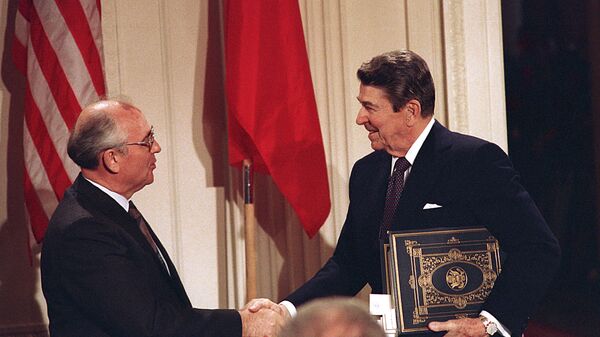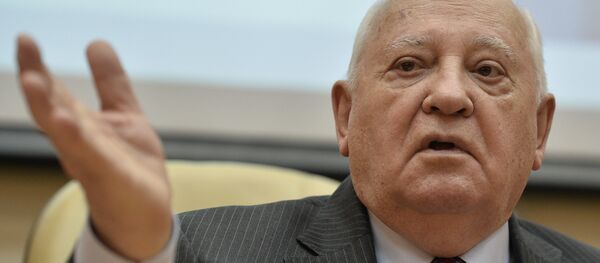The Treaty Between the United States and the Union of Soviet Socialist Republics on the Elimination of Their Intermediate-Range and Shorter-Range Missiles, commonly referred to as the INF, was signed on December 8, 1987, in Washington by then General Secretary of the Communist Party of the Soviet Union Mikhail Gorbachev and then US President Ronald Reagan. The treaty entered into force on June 1, 1988.
READ MORE: Macron Stresses Importance of INF Treaty for EU Security in Call With Trump
Since the collapse of the Soviet Union, the obligations under the treaty's have been met by the United States and former USSR republics of Russia, Belarus, Kazakhstan and Ukraine.
Under the treaty, the sides pledged not to manufacture, test or deploy medium-range (1,000-5,500 kilometers, or 620-3,420 miles) and shorter-range (500-1,000 kilometers) ballistic missiles and ground-launched cruise missiles. They also pledged to destroy all launchers and ground-based missiles with a range of 500-5,500 kilometers.
The Soviet Union pledged to destroy Pioneer-type, R-12 and R-14 (SS-20, SS-4 and SS-5) medium-range ballistic missiles, RK-55 (SSC-X-4 Slingshot) ground-launched cruise missiles, as well as the OTR-22 (SS-12M Scaleboard) and OTR-23 Oka (S-23 Spider) shorter-range ballistic missiles.
The requirements of the treaty were fully carried out by May 1991. The USSR destroyed 1,846 missile systems, with the United States having eliminated 846.
Soviet missiles were eliminated by being blown up, while 72 Pioneer medium-range ballistic missiles were destroyed by launches from field positions. The United States eliminated Pershing missiles by burning through their bodies but preserving the guidance system compartments, which were later used to manufacture medium-range missile drones.
Missile manufacturing equipment, missile bases and expert training centers were eliminated as well. The Soviet Union and the United States eliminated a total of 117 and 32 facilities, respectively.
Both sides conducted onsite inspections on compliance with the treaty until May 30, 2001, including permanent inspections at checkpoints of the Votkinsk Engineering Plant in Udmurtia, Russia, and the Hercules Inc. plant in Magna, Utah, the United States.
Members of the Special Verification Commission (SVC) reviewed the issues of the treaty’s implementation and coordinating measures to make the treaty more viable and efficient. The commission members held 29 sessions by October 2003. After that, no sessions took place for a long time since Russia and the United States had by then completed all the projects under the treaty.
On October 12, 2007, Russian President Vladimir Putin met with Russian and US defense and foreign ministers and suggested the introduction of universal INF treaty obligations. The United States supported the proposal.
On October 25, 2007, a joint Russian-US statement on the INF treaty was introduced at the 62nd UN General Assembly session. The document urged all the concerned countries to discuss the possibility of introducing the universal INF treaty obligations by renouncing the use of ground-based ballistic and cruise missiles with a range of 500-5,500 kilometers.
On February 12, 2008, Russian Foreign Minister Sergey Lavrov spoke at a plenary session of the Disarmament Conference in Geneva and suggested to jointly search for optimal methods to advance the above-mentioned initiative. Lavrov also submitted a draft document on the main provisions of an agreement on the elimination of ground-based medium-range and shorter-range missiles in accordance with international law. Despite Russia’s efforts, this initiative was never implemented.
Since 2013, the United States has been accusing Russia of violating the INF treaty. Washington accused Moscow of testing and deploying the 9M729 ground-launched cruise missile, claiming it has a range of over 500 kilometers, and thus violates the INF treaty. The Russian side denies these allegations. The US side, for its part, declines to specify the circumstances that formed the basis of their claims.
READ MORE: Prof Explains Why Trump's Vow to Exit INF Treaty 'Focused in Part on China'
In turn, Russia says that the United States is the one that violated the INF treaty by unlawful unilateral withdrawal of armed drones (which meet the definition "ground-based cruise missile" in the treaty) at a range beyond the limit set by the treaty from under the scope of the INF treaty; maintenance of a technological capability of medium- and shorter-range ground-based missiles by testing it on a wide range of target missiles during tests declared as anti-missile; ground deployment of the Aegis Ashore MK-41 missile launching systems, which can be used to launch Tomahawk long-range cruise missiles and other attack missile systems, at European facilities of the US global missile defense system.
Although the INF treaty has an unlimited duration, each side has the right to denounce it by providing convincing arguments for the need to withdraw from the treaty.
Members of the US Congress have repeatedly called for drafting a bill that would directly accuse Russia of violating the treaty and would pave the way for the US withdrawal from it along the same lines as from the Anti-Ballistic Missile (ABM) treaty.
In the summer of 2018, Trump signed the country’s fiscal year 2019 Defense Budget, in which, as well as in previous budgets, Russia is accused of violating the INF treaty.







